Correlations between Energy Dissipation Characteristics and the Rheological Property Degradation of Asphalt Binders
Abstract
:1. Introduction
2. Materials and Testing
2.1. Asphalt Binders
2.2. Stress Control Time Scanning Test Plan
2.3. Fatigue Test Life Evaluation Indicators
2.3.1. Evaluation Indicators for Dissipated Energy in Fatigue Testing
2.3.2. Evaluation Indicators for Dissipation Energy Ratio and Cumulative Dissipation Energy Ratio
2.3.3. Dissipated Energy Change Rate Evaluation Index
2.3.4. n × Gn* Evaluation Indicators
3. Results and Discussion
3.1. Relationship between Energy Dissipation and Rheological Property Degradation of Cementitious Materials
3.2. Applicability Analysis of Dissipative Energy Fatigue Criterion under Constant Stress
3.2.1. Analysis Results of Evaluation Indicators for Dissipation Energy Ratio and Cumulative Dissipation Energy Ratio
3.2.2. Analysis Results of n × Gn* Evaluation Indicators
3.2.3. Applicability Analysis of Various Dissipative Energy Parameters
3.3. Applicability Analysis of Dissipated Energy Fatigue Criterion under Variable Stress
3.3.1. Curve of Dissipated Energy Change Rate and G-R Constant Change
3.3.2. Applicability Analysis of Various Dissipative Energy Parameters
4. Conclusions
Author Contributions
Funding
Data Availability Statement
Acknowledgments
Conflicts of Interest
References
- Zhuang, W.; Li, S.; Yu, Q. The effect of supplementary cementitious material systems on dynamic compressive properties of ultra-high performance concrete paste. Constr. Build. Mater. 2022, 321, 126361. [Google Scholar] [CrossRef]
- Yu, H.; Deng, G.; Zhang, Z.; Zhu, M.; Gong, M.; Oeser, M. Workability of rubberized asphalt from a perspective of particle effect. Transp. Res. Part D Transp. Environ. 2021, 91, 102712. [Google Scholar] [CrossRef]
- Shen, S.; Airey, G.D.; Carpenter, S.H.; Huang, H. A dissipated energy approach to fatigue evaluation. Road Mater. Pavement Des. 2006, 7, 47–69. [Google Scholar] [CrossRef]
- Izadifar, M.; Königer, F.; Gerdes, A.; Wöll, C.; Thissen, P. Correlation between Composition and Mechanical Properties of Calcium Silicate Hydrates Identified by Infrared Spectroscopy and Density Functional Theory. J. Phys. Chem. C 2019, 123, 10868–10873. [Google Scholar] [CrossRef]
- Izadifar, M.; Dolado, J.S.; Thissen, P.; Ukrainczyk, N.; Koenders, E.; Ayuela, A. Theoretical Elastic Constants of Tobermorite Enhanced with Reduced Graphene Oxide through Hydroxyl vs. Epoxy Functionalization: A First-Principles Study. J. Phys. Chem. C 2023, 127, 18117–18126. [Google Scholar] [CrossRef]
- Yu, H.; Zhu, Z.; Leng, Z.; Wu, C.; Zhang, Z.; Wang, D.; Oeser, M. Effect of mixing sequence on asphalt mixtures containing waste tire rubber and warm mix surfactants. J. Clean. Prod. 2020, 246, 119008. [Google Scholar] [CrossRef]
- Yu, H.; Leng, Z.; Zhou, Z.; Shih, K.; Xiao, F.; Gao, Z. Optimization of preparation procedure of liquid warm mix additive modified asphalt rubber. J. Clean. Prod. 2017, 141, 336–345. [Google Scholar] [CrossRef]
- Liu, S.; Jin, J.; Yu, H.; Qian, G.; Zhang, B.; Shi, J.; Gao, Y. Promotional effect of shaped coal gangue composite phase change agents doping in asphalt on pavement properties. Constr. Build. Mater. 2024, 411, 134447. [Google Scholar] [CrossRef]
- Jin, J.; Gao, Y.; Wu, Y.; Liu, S.; Liu, R.; Wei, H.; Qian, G.; Zheng, J. Rheological and adhesion properties of nano-organic palygorskite and linear SBS on the composite modified asphalt. Powder Technol. 2021, 377, 212–221. [Google Scholar] [CrossRef]
- Jamshidi, A.; Hamzah, M.O.; Shahadan, Z.; Yahaya, A.S. Evaluation of the rheological properties and activation energy of virgin and recovered asphalt binder blends. J. Mater. Civ. Eng. 2015, 27, 04014135. [Google Scholar] [CrossRef]
- Shen, S.; Sutharsan, T. Quantification of cohesive healing of asphalt binder and its impact factors based on dissipated energy analysis. Road Mater. Pavement Des. 2011, 12, 525–546. [Google Scholar] [CrossRef]
- Wang, T.; Li, M.; Cai, X.; Cheng, Z.; Zhang, D.; Sun, G. Multi-objective design optimization of composite polymerized asphalt emulsions for cold patching of pavement potholes. Mater. Today Commun. 2023, 35, 105751. [Google Scholar] [CrossRef]
- Santagata, E.; Baglieri, O.; Dalmazzo, D.; Tsantilis, L. Investigating cohesive healing of asphalt binders by means of a dissipated energy approach. Int. J. Pavement Res. Technol. 2017, 10, 403–409. [Google Scholar] [CrossRef]
- Ameri, M.; Seif, M.; Abbasi, M.; Molayem, M.; KhavandiKhiavi, A. Fatigue performance evaluation of modified asphalt binder using of dissipated energy approach. Constr. Build. Mater. 2017, 136, 184–191. [Google Scholar] [CrossRef]
- Ashish, P.K.; Singh, D.; Jain, R. Evaluating the effect of carbon nanotube on low temperature property of asphalt binder through dissipated energy–based approach. J. Mater. Civ. Eng. 2020, 32, 04019376. [Google Scholar] [CrossRef]
- Mohamed, A.S.; Cao, Z.; Xu, X.; Xiao, F.; Abdel-Wahed, T. Bonding, rheological, and physiochemical characteristics of reclaimed asphalt rejuvenated by crumb rubber modified binder. J. Clean. Prod. 2022, 373, 133896. [Google Scholar] [CrossRef]
- Al-Haddad, A.H. Fatigue evaluation of Iraqi asphalt binders based on the dissipated energy and viscoelastic continuum damage (VECD) approaches. J. Civ. Eng. Constr. Technol. 2015, 6, 27–50. [Google Scholar]
- Ameri, M.; Mansourkhaki, A.; Daryaee, D. Evaluation of fatigue behavior of asphalt binders containing reclaimed asphalt binder using simplified viscoelastic continuum damage approach. Constr. Build. Mater. 2019, 202, 374–386. [Google Scholar] [CrossRef]
- Wang, T.; Weng, Y.; Cai, X.; Li, J.; Xiao, F.; Sun, G.; Zhang, F. Statistical modeling of low-temperature properties and FTIR spectra of crumb rubber modified asphalts considering SARA fractions. J. Clean. Prod. 2022, 374, 134016. [Google Scholar] [CrossRef]
- Farrar, M.J.; Kim, S.-S.; Pauli, T.; Planche, J.P. An advanced low temperature rheological and fracture test method for bitumen purchase specifications and pavement performance prediction: 4-mm DSR/ABCD. In Proceedings of the 8th RILEM International Symposium on Testing and Characterization of Sustainable and Innovative Bituminous Materials; Springer: Dordrecht, The Netherlands, 2015; pp. 25–36. [Google Scholar]
- Van Dijk, W. Practical Fatigue Characterization of Bituminous Mixes; Shell International Petroleum Company Limited: London, UK, 1975. [Google Scholar]
- Kim, Y.-R.; Little, D.; Lytton, R. Fatigue and healing characterization of asphalt mixtures. J. Mater. Civ. Eng. 2003, 15, 75–83. [Google Scholar] [CrossRef]
- Hopman, P.; Kunst, P.; Pronk, A. A renewed interpretation method for fatigue measurements-verification of Miner’s rule. In Proceedings of the 4th Eurobitume Symposium, Madrid, Spain, 4–6 October 1989; pp. 557–561. [Google Scholar]
- Ghuzlan, K.A.; Carpenter, S.H. Energy-derived, damage-based failure criterion for fatigue testing. Transp. Res. Rec. 2000, 1723, 141–149. [Google Scholar] [CrossRef]
- Rowe, G.; King, G.; Anderson, M. The influence of binder rheology on the cracking of asphalt mixes in airport and highway projects. J. Test. Eval. 2014, 42, 1063–1072. [Google Scholar] [CrossRef]
- Glover, C.J.; Davison, R.R.; Domke, C.H.; Ruan, Y.; Juristyarini, P.; Knorr, D.B. Development of a New Method for Assessing Asphalt Binder Performance Durability; Federal Highway Administration Report TX-02/1872-1; Federal Highway Administration: Washington, DC, USA, 2001. [Google Scholar]
- Wang, T.; Dra, Y.A.S.S.; Cai, X.; Cheng, Z.; Zhang, D.; Lin, Y.; Yu, H. Advanced cold patching materials (CPMs) for asphalt pavement pothole rehabilitation: State of the art. J. Clean. Prod. 2022, 366, 133001. [Google Scholar] [CrossRef]
- Chen, H.; Zhang, Y.; Bahia, H.U. The role of binders in mixture cracking resistance measured by ideal-CT test. Int. J. Fatigue 2021, 142, 105947. [Google Scholar] [CrossRef]
- Liu, Z.; Wu, W.; Gu, X.; Li, S.; Wang, L.; Zhang, T. Application of combining YOLO models and 3D GPR images in road detection and maintenance. Remote Sens. 2021, 13, 1081. [Google Scholar] [CrossRef]
- ASTM D7175-15; Standard Test Method for Determining the Rheological Properties of Asphalt Binder Using a Dynamic Shear Rheometer. ASTM International: West Conshohocken, PA, USA, 2015.
- Zhang, Y.; Gao, Y. Predicting crack growth in viscoelastic bitumen under a rotational shear fatigue load. Road Mater. Pavement Des. 2021, 22, 603–622. [Google Scholar] [CrossRef]
- Pronk, A. Comparison of 2 and 4 point fatigue tests and healing in 4 point dynamic bending test based on the dissipated energy concept. In Proceedings of the Eighth International Conference on Asphalt PavementsFederal Highway Administration, Seattle, WA, USA, 10–14 August 1997. [Google Scholar]
- Planche, J.-P.; Anderson, D.; Gauthier, G.; Le Hir, Y.; Martin, D. Evaluation of fatigue properties of bituminous binders. Mater. Struct. 2004, 37, 356–359. [Google Scholar] [CrossRef]
- Zhang, Z.; Oeser, M. Energy dissipation and rheological property degradation of asphalt binder under repeated shearing with different oscillation amplitudes. Int. J. Fatigue 2021, 152, 106417. [Google Scholar] [CrossRef]
- Shen, S.; Lu, X. Energy Based Laboratory Fatigue Failure Criteria for Asphalt Materials; ASTM International: West Conshohocken, PA, USA, 2011. [Google Scholar]
- Rowe, G.M.; Bouldin, M.G. Improved techniques to evaluate the fatigue resistance of asphaltic mixtures. In Proceedings of the 2nd Eurasphalt & Eurobitume Congress, Barcelona, Spain, 20–22 September 2000. [Google Scholar]
- Liu, H.; Luo, R. Development of failure criterion and fatigue model to characterize the fatigue resistance of asphalt binders under controlled-stress time sweep tests. Mater. Struct. 2019, 53, 5. [Google Scholar] [CrossRef]
- Kommidi, S.R.; Kim, Y.-R.; de Rezende, L.R. Fatigue characterization of binder with aging in two length scales: Sand asphalt mortar and parallel plate binder film. Constr. Build. Mater. 2020, 237, 117588. [Google Scholar] [CrossRef]
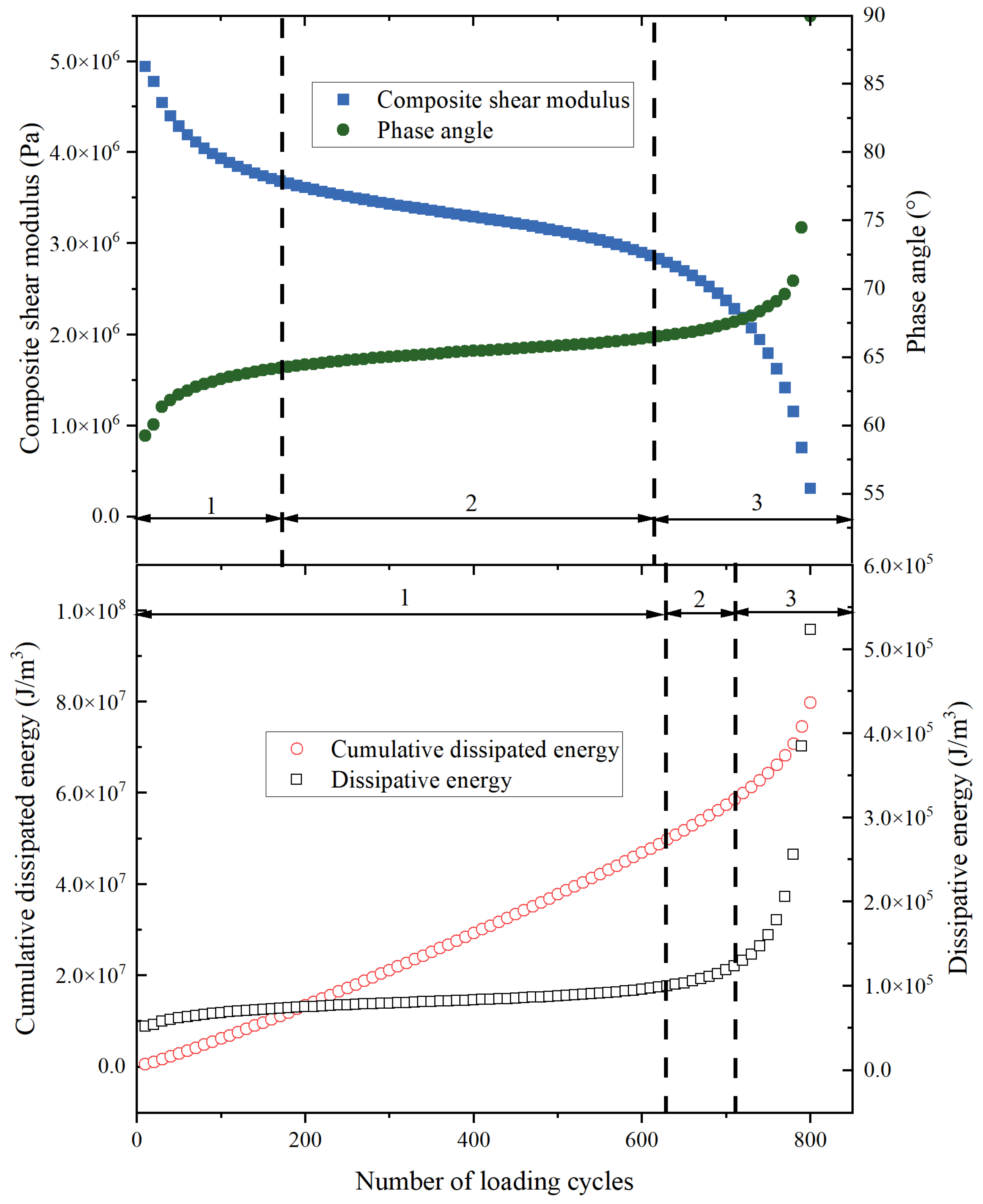
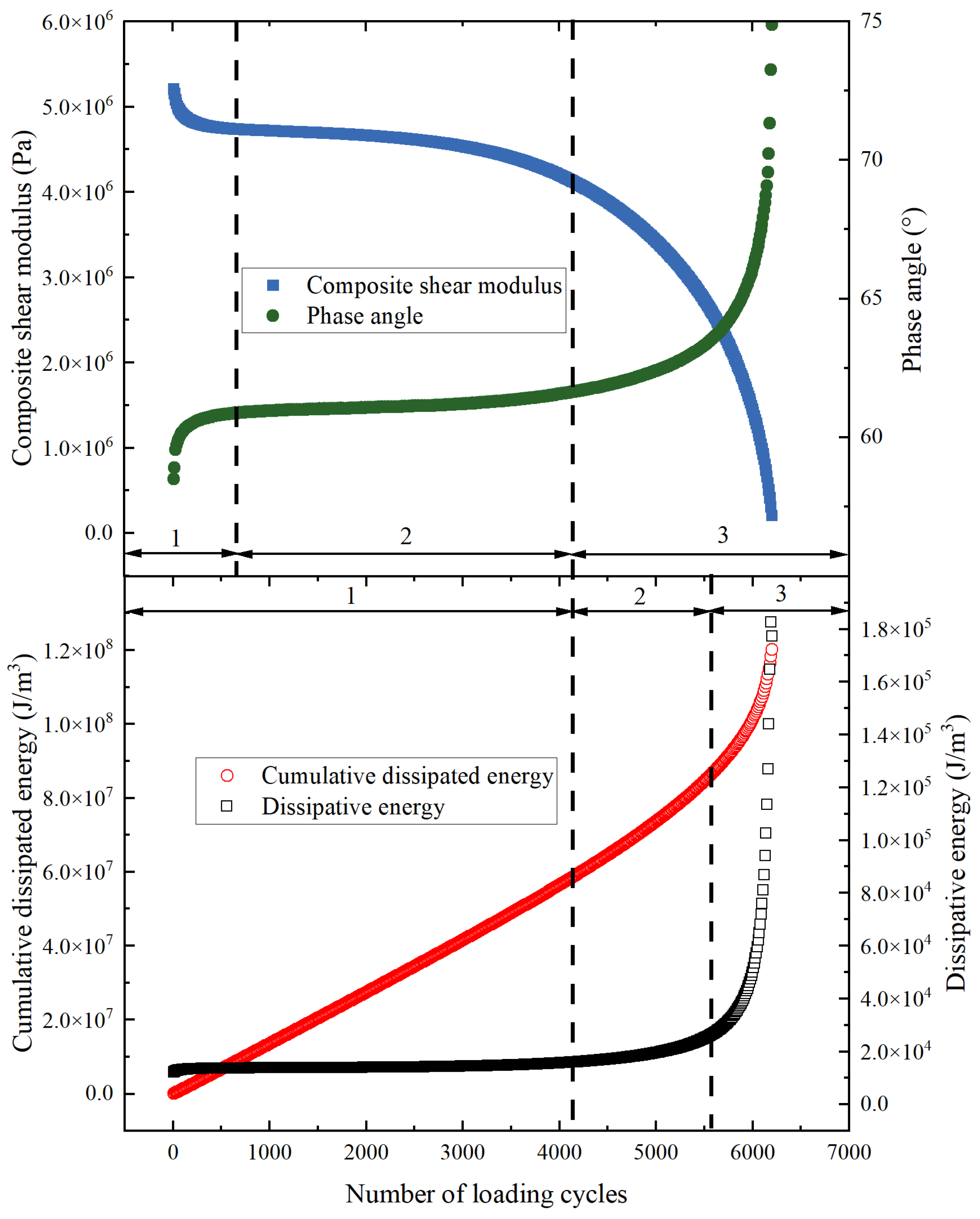
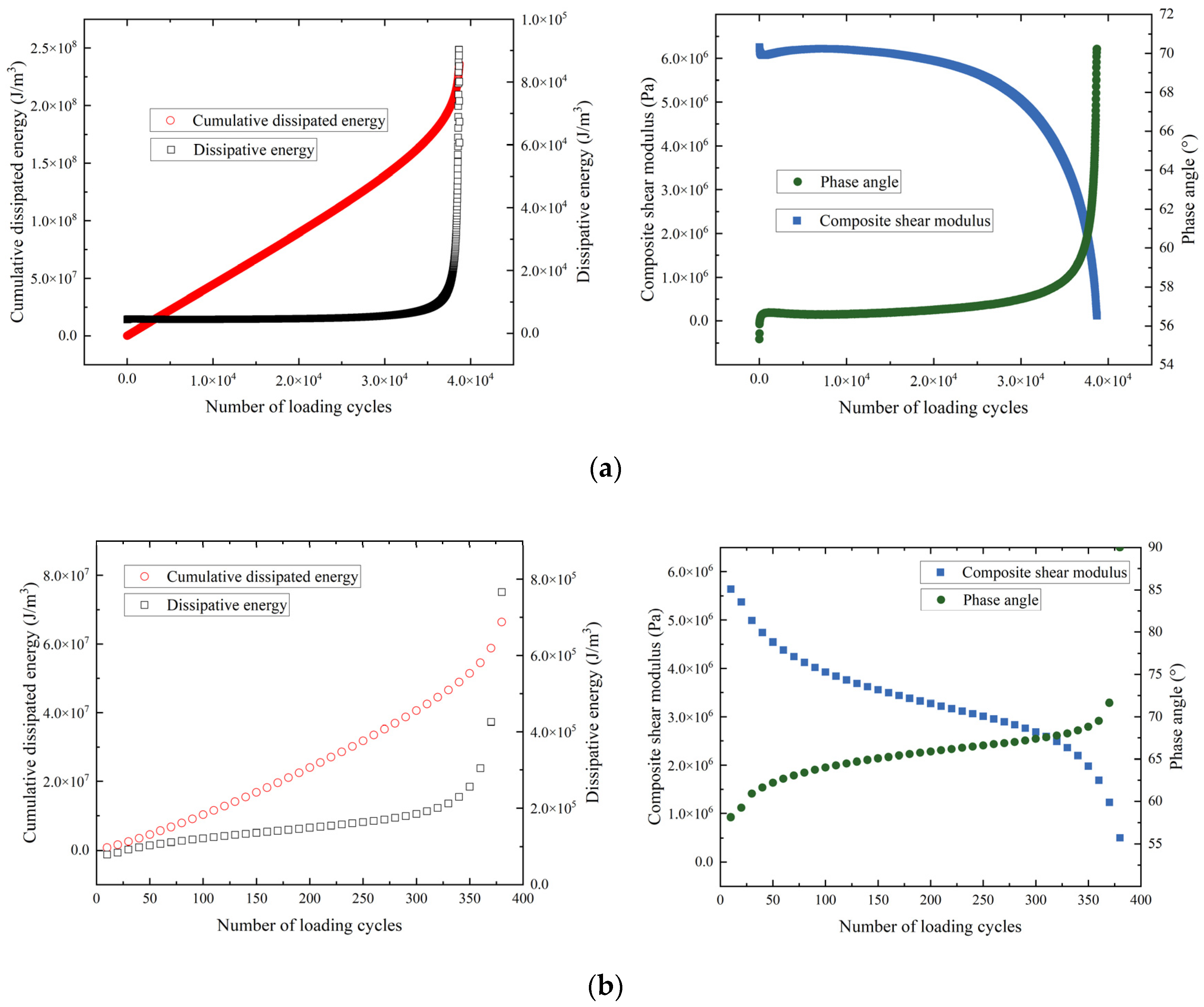

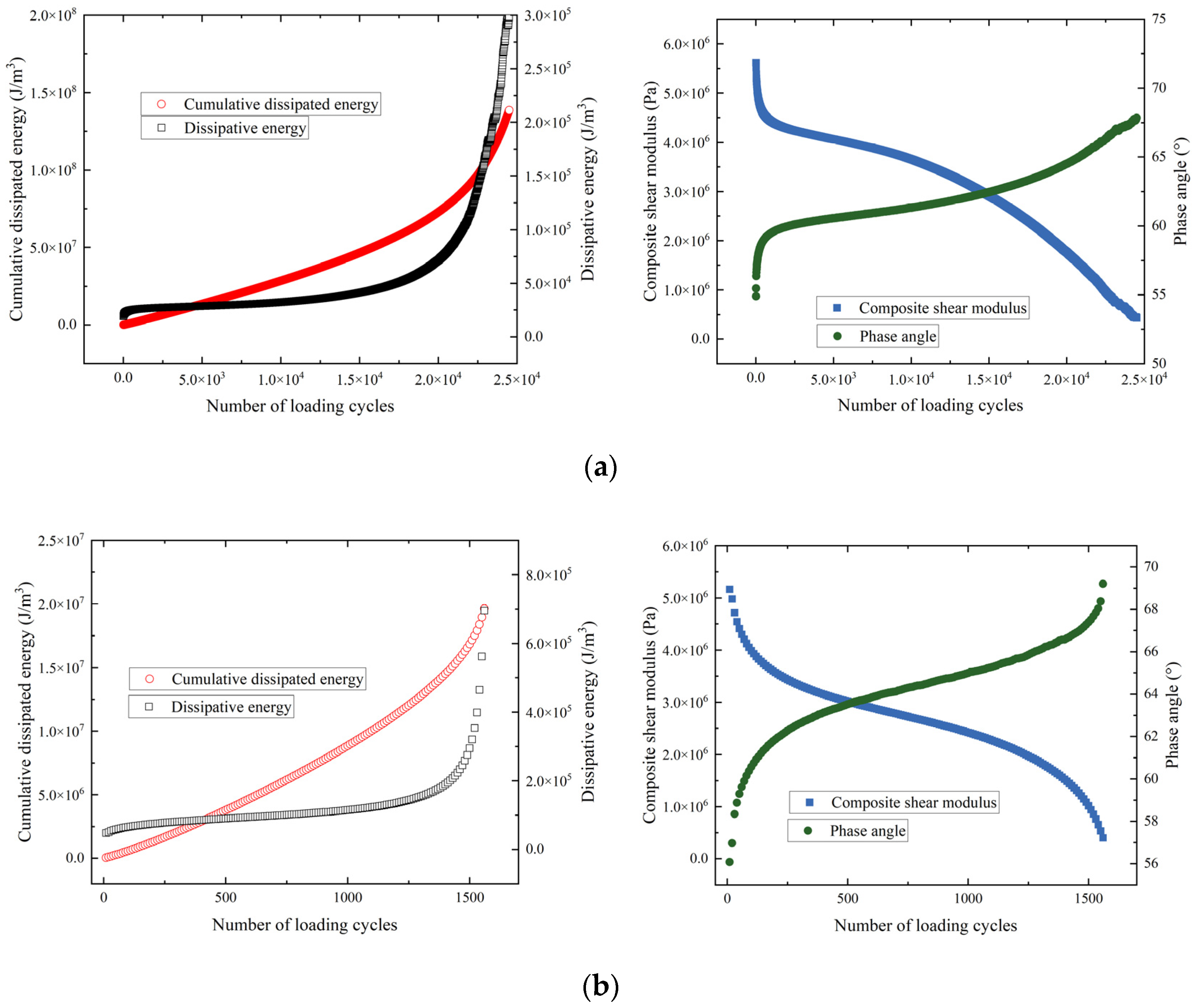
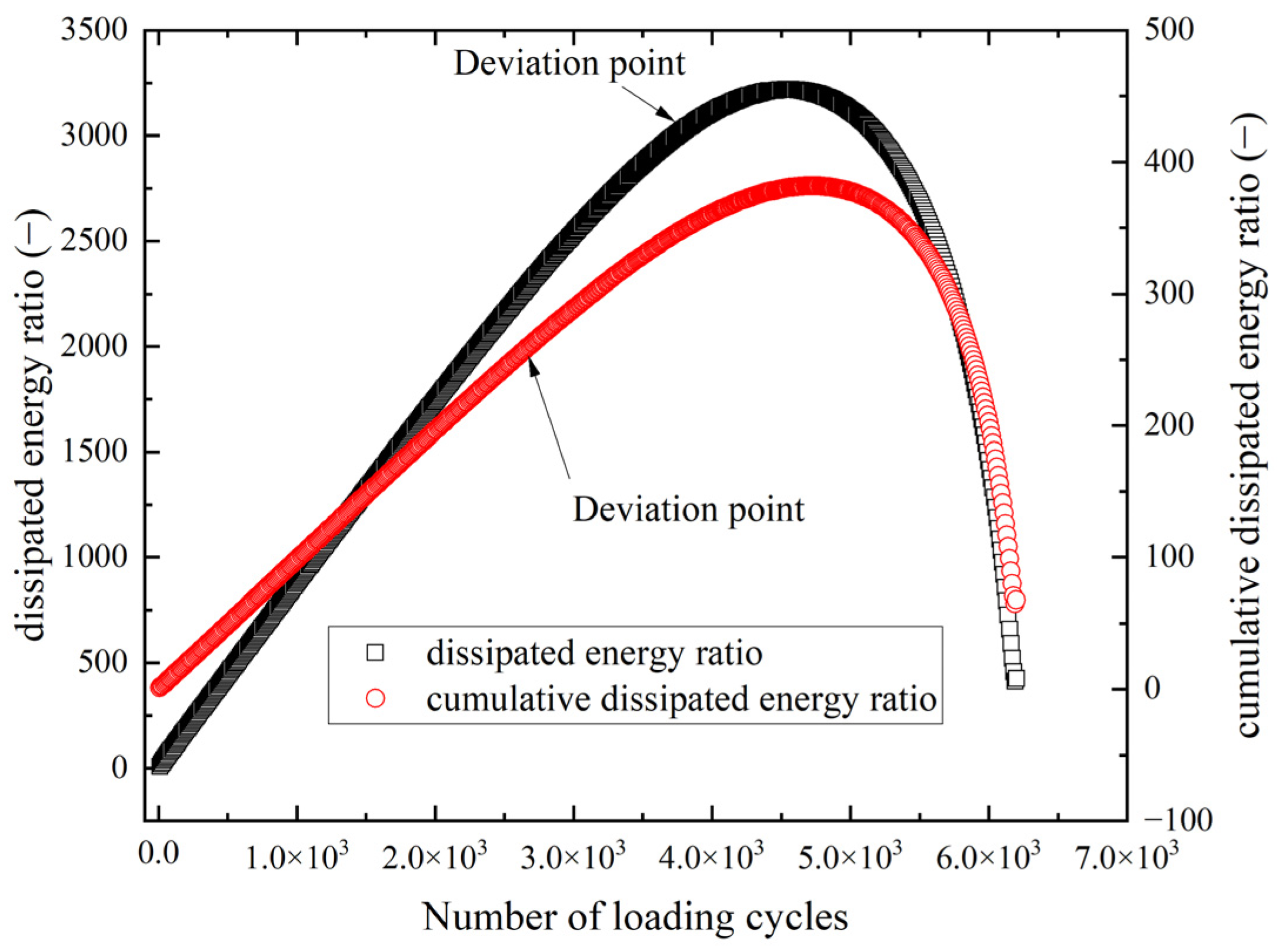
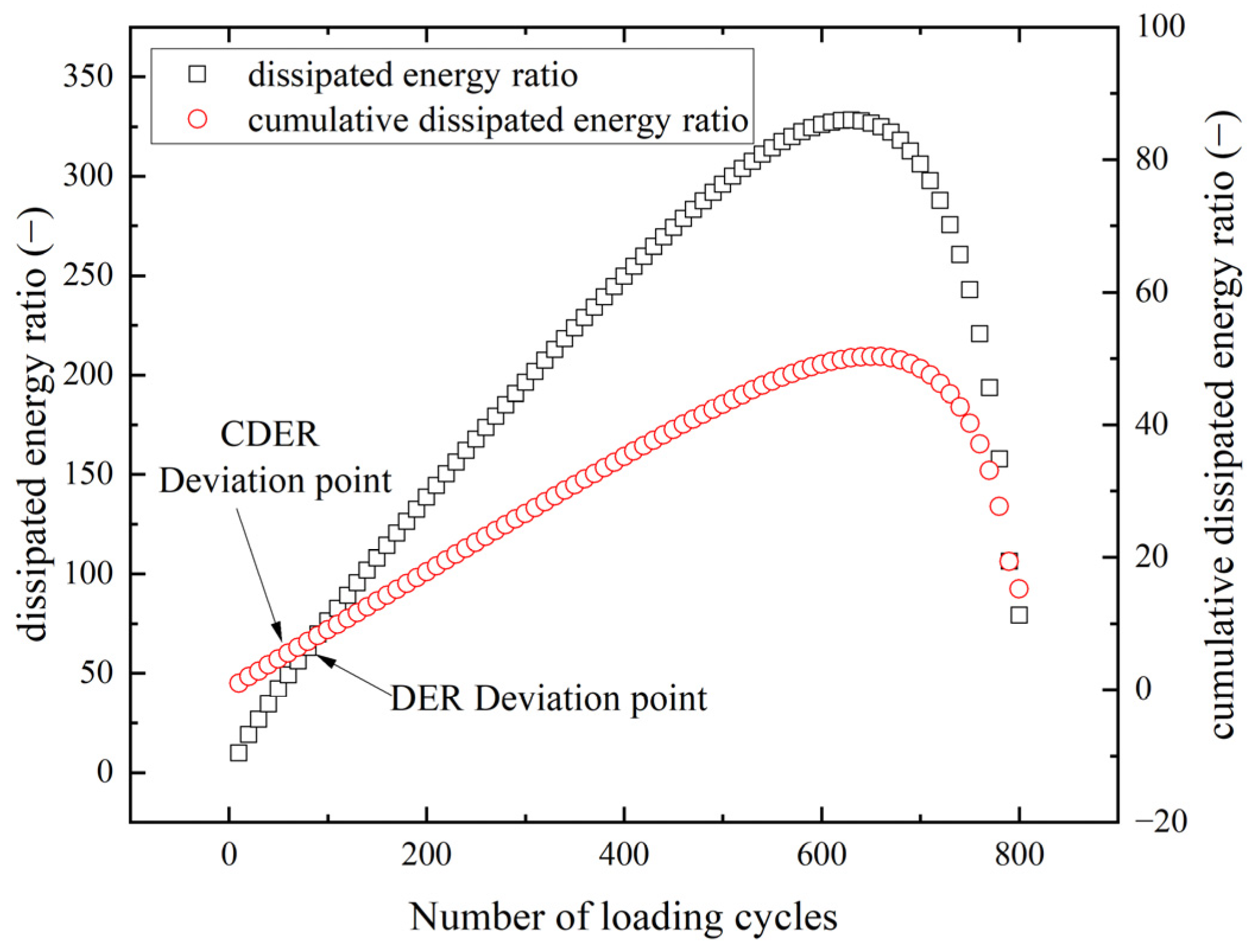
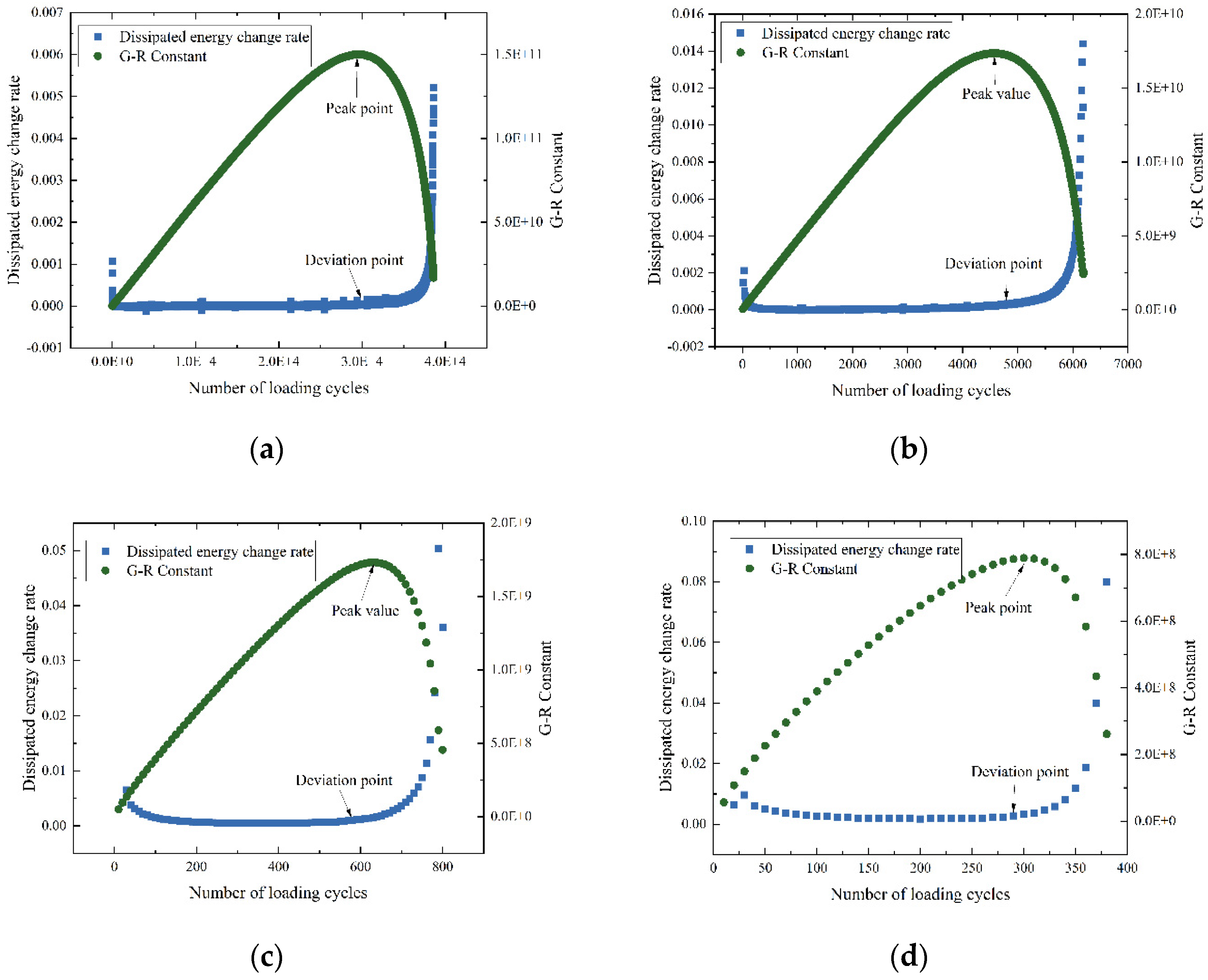
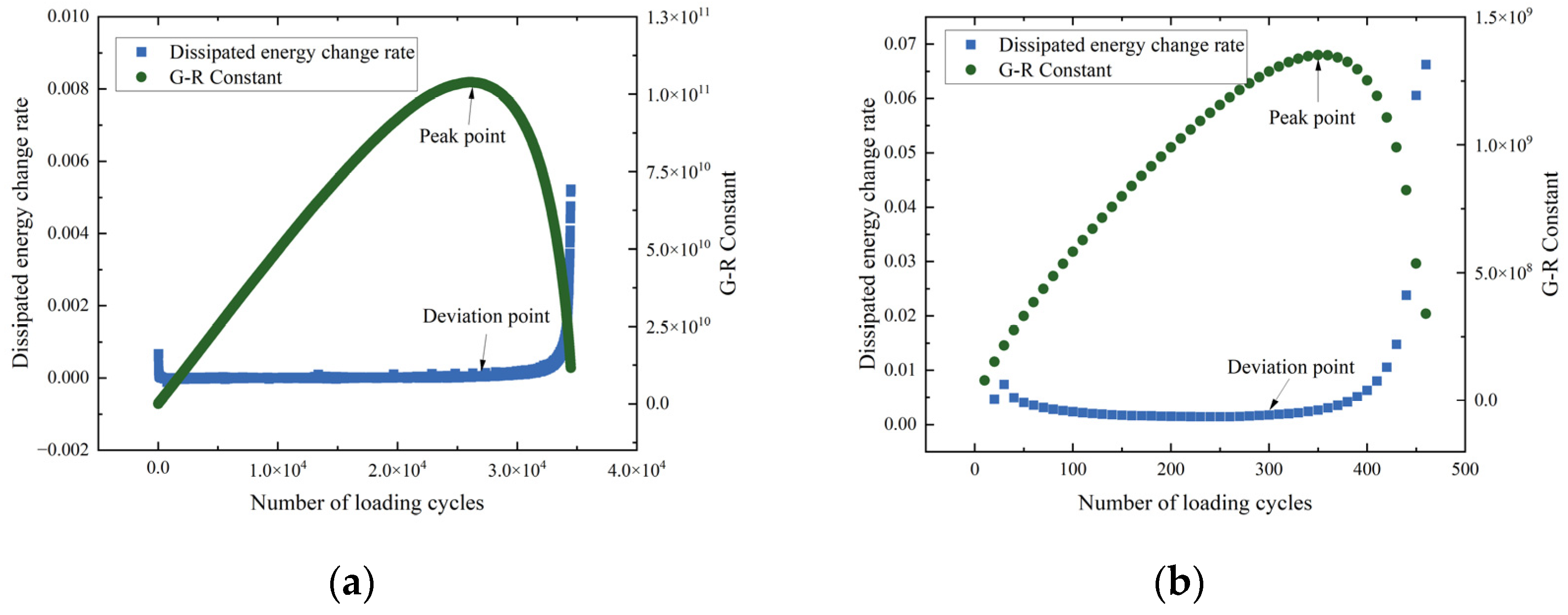

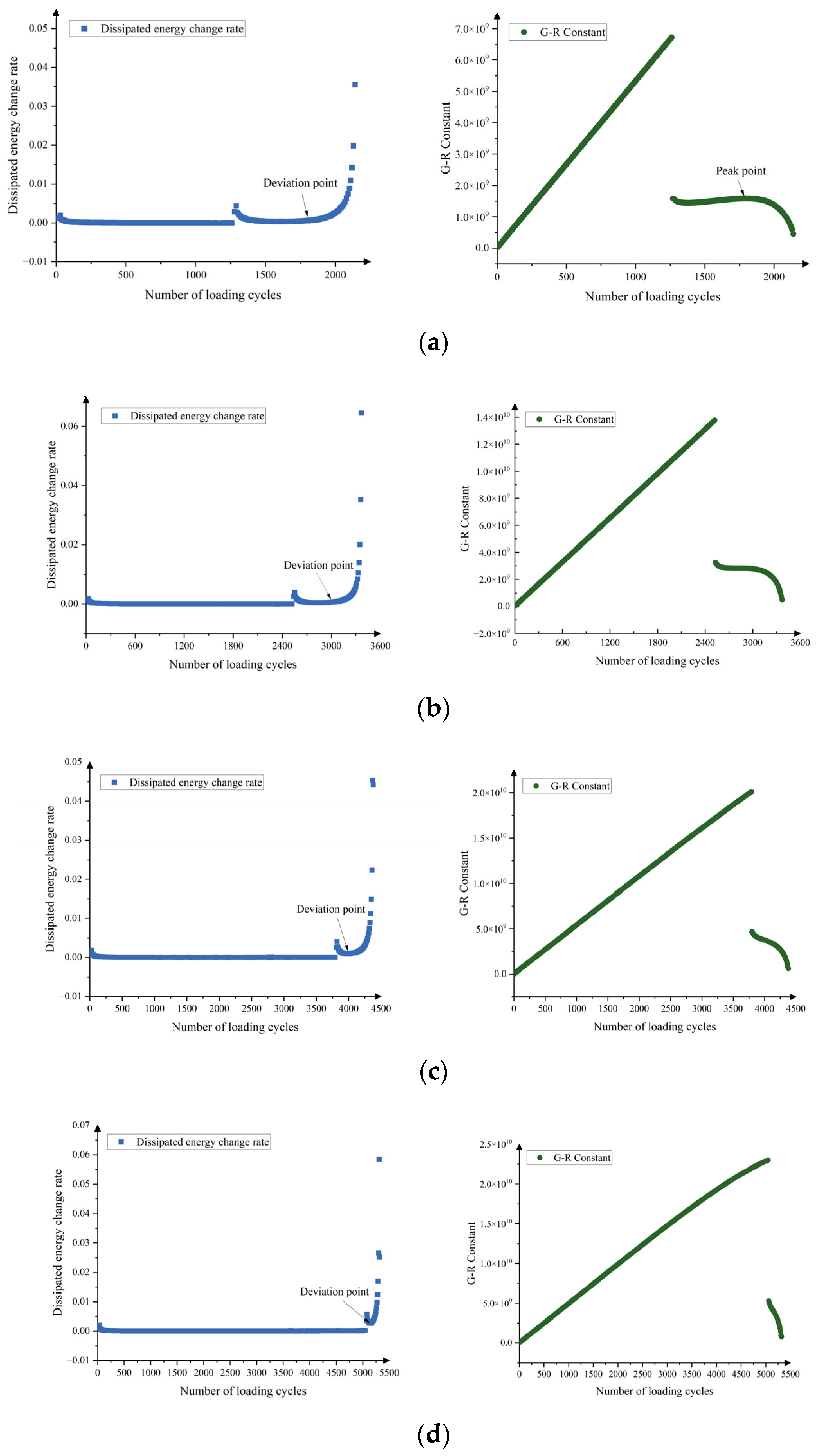
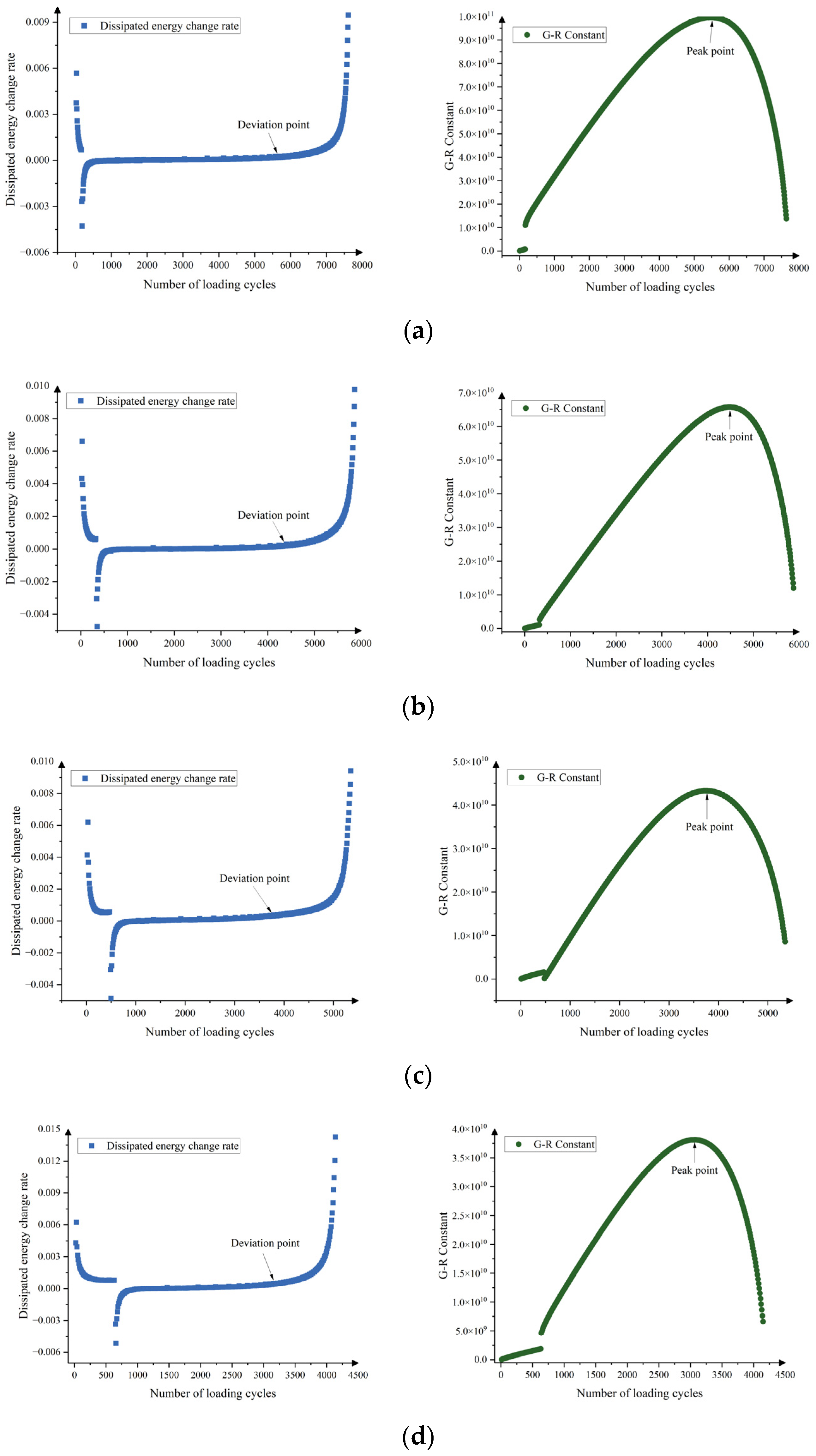
| Testing Items | Unit | Pen60–70 | Pen70–80 | SBS | Test Specifications |
|---|---|---|---|---|---|
| Penetration (25 °C, 100 g, 5 s) | 0.1 mm | 64 | 72 | 56 | T0604 |
| Softening point (TR&B) | °C | 48 | 49 | 64 | T0606 |
| Ductility (10 °C, 5 cm/min) | cm | 67 | >100 | 43 | T0605 |
| Kinematic viscosity (135 °C) | Pa·s | 0.21 | 0.34 | 1.95 | T0620 |
| Change in residue quality after RTFOT | % | 0.102 | 0.079 | 0.045 | T0609 |
| Binder Types | Test Number | First Stage Stress (kPa) | Second Stage Stress (kPa) | First Stage Damage Score | Number of Stress Cycles in the Second Stage Nf2 |
|---|---|---|---|---|---|
| Pen70–80 | 150-300-1 | 150 | 300 | 0.2 | Measured value |
| 150-300-2 | 150 | 300 | 0.4 | Measured value | |
| 150-300-3 | 150 | 300 | 0.6 | Measured value | |
| 150-300-4 | 150 | 300 | 0.8 | Measured value | |
| Pen70–80 | 300-150-1 | 300 | 150 | 0.2 | Measured value |
| 300-150-2 | 300 | 150 | 0.4 | Measured value | |
| 300-150-3 | 300 | 150 | 0.6 | Measured value | |
| 300-150-4 | 300 | 150 | 0.8 | Measured value | |
| Pen60–70 | 250-400-1 | 250 | 400 | 0.2 | Measured value |
| 250-400-2 | 250 | 400 | 0.4 | Measured value | |
| 250-400-3 | 250 | 400 | 0.6 | Measured value | |
| 250-400-4 | 250 | 400 | 0.8 | Measured value | |
| SBS modified binder | 200-300-1 | 200 | 300 | 0.2 | Measured value |
| 200-300-2 | 200 | 300 | 0.4 | Measured value | |
| 200-300-3 | 200 | 300 | 0.6 | Measured value | |
| 200-300-4 | 200 | 300 | 0.8 | Measured value |
| Stress Amplitude (kPa) | 100 | 150 | 300 | 400 |
|---|---|---|---|---|
| Nf-R | 30,060 | 4860 | 580 | 290 |
| Nf-P | 29,370 | 4570 | 630 | 300 |
| Load Mode | First Stage Lifespan | Second Stage Lifespan Nf-R | Second Stage Lifespan Nf-P |
|---|---|---|---|
| 150-300-1 | 1262 | 518 | 548 |
| 150-300-2 | 2524 | 486 | - |
| 150-300-3 | 3786 | 204 | - |
| 150-300-4 | 5048 | 102 | - |
| Load Mode | First Stage Lifespan | Second Stage Lifespan Nf-R | Second Stage Lifespan Nf-P |
|---|---|---|---|
| 300-150-1 | 158 | 5412 | 5372 |
| 300-150-2 | 316 | 4286 | 4164 |
| 300-150-3 | 474 | 3460 | 3296 |
| 300-150-4 | 632 | 2588 | 2438 |
Disclaimer/Publisher’s Note: The statements, opinions and data contained in all publications are solely those of the individual author(s) and contributor(s) and not of MDPI and/or the editor(s). MDPI and/or the editor(s) disclaim responsibility for any injury to people or property resulting from any ideas, methods, instructions or products referred to in the content. |
© 2024 by the authors. Licensee MDPI, Basel, Switzerland. This article is an open access article distributed under the terms and conditions of the Creative Commons Attribution (CC BY) license (https://creativecommons.org/licenses/by/4.0/).
Share and Cite
Yu, H.; Deng, Y.; Deng, G.; Dong, N. Correlations between Energy Dissipation Characteristics and the Rheological Property Degradation of Asphalt Binders. Buildings 2024, 14, 292. https://doi.org/10.3390/buildings14010292
Yu H, Deng Y, Deng G, Dong N. Correlations between Energy Dissipation Characteristics and the Rheological Property Degradation of Asphalt Binders. Buildings. 2024; 14(1):292. https://doi.org/10.3390/buildings14010292
Chicago/Turabian StyleYu, Huayang, Yihao Deng, Guansen Deng, and Niya Dong. 2024. "Correlations between Energy Dissipation Characteristics and the Rheological Property Degradation of Asphalt Binders" Buildings 14, no. 1: 292. https://doi.org/10.3390/buildings14010292




